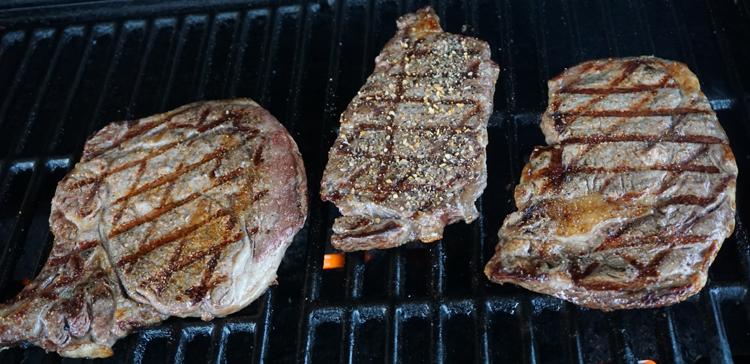How to Tell When a Grilled Steak Is Done
Consumer Reports tests the "Hand Method" to determine if a steak is done. You might be surprised how it turned out!

As a trained chef, I've learned to embrace the barrage of culinary queries from friends and family. “Can I swap out curly parsley if I can’t find Italian flat-leaf?” “What’s the easiest way to chop an onion?” And so on. But the question chefs probably hear the most—and have the hardest time answering—is how to know when a steak is done.
It can be difficult to explain because the real trick is cooking enough steaks to develop a sixth sense for internal temperature. Absent the intuition that comes from years of practice, a meat thermometer is the way to go—both for food safety and to ensure you don’t overcook a pricey prime porterhouse.
Some people think using a thermometer when grilling is a cheat, or maybe they had bad experiences in the past with older, leave-in analog meat thermometers, which routinely do poorly in CR's tests. But using a digital meat thermometer is the best way to make sure the meat is cooked to a safe internal temperature.
The Hand Method
One of the most popular methods of determining whether a steak is done is something called the hand method, a decidedly unscientific touch test that calls for holding one hand palm up and using the index finger of the opposite hand to press the ball joint below your thumb. So the thinking goes, that squishy feeling is how the center of a steak should feel when it's rare.
Making a pincer grip with your thumb and index finger—causing the joint to tense slightly—is how a steak should feel at medium rare. The same motion repeated with the middle, ring, and pinky fingers represent medium, medium-well, and well-done, respectively, or so the lore goes.
To see whether there's any validity to the idea, Consumer Reports put the hand method to the test. We used the Weber Genesis E-410, $900, a model we chose for its perfectly even heating in our gas grill tests.
We then grilled five sirloin steaks. The steaks were all cut to the same thickness, and we grilled them one-by-one at the same temperature. For reference, we cross-checked the temperatures with our top-rated Oregon Scientific Wireless BBQ/Oven AW131 meat thermometer, $40, and logged the final temperature before cutting in to see how the steak looked.
Here's how it all turned out.
How We Tested the Hand Method
Like the USDA, Consumer Reports recommends cooking whole cuts of beef to a minimum internal temperature of 145° F. "With steaks, any bacteria present is likely to be on the surface of the meat and 145° F is hot enough to kill those bacteria," says James E. Rogers, Ph.D., director of food safety and testing at Consumer Reports.
In our hand method test, we checked the steaks at every stage from rare to well-done and compared the results to widely recommended internal temperatures from outside sources.
Rare
- Target temperature: 125° F
- Temperature with hand method: 106° F
Did it work? No. While Consumer Reports never recommends cooking steak rare, the hand method posed an extra risk here, as it caused our test steak to come in a full 19° F below the already risky internal temperature of 125° F.
Medium-Rare
- Target temperature: 135° F
- Temperature with hand method: 110° F
Did it work? No. Again, the hand method yielded a result that would be well below what most would consider medium-rare. Cutting into the steak revealed a thin red band and saturated pink meat throughout, and was pretty consistent with a steak we'd consider rare.
Medium
- Target temperature: 145° F
- Temperature with hand method: 127° F
Did it work? No. Medium steaks are among the hardest to master because medium means something different to almost everyone. Again, the hand method yielded an undercooked steak. The thermometer told a different story. Despite looking like a steak cooked medium, it was still 18° F below a temperature we'd consider safe.
Medium-Well
- Target temperature: 155° F
- Temperature with hand method: 142° F
Did it work? No. For our medium-well steaks, we also found the hand method lacking. We got a steak most people would call medium, and according to the thermometer, it was still 3° F shy of the minimum safe temperature recommended by the USDA.
Well-Done
- Target temperature: 165° F
- Temperature with hand method: 157° F
Did it Work? No. Cooking a steak well-done sounds easy enough, but the line between eliminating any traces of pink and overcooking the meat is a fine one. Once again, the hand method produced a result that was a bit on the undercooked side. That can be off-putting if you prefer a steak with no traces of pink.
The Verdict
The hand method receives a thumbs-down. Although the steaks in our test did firm up as internal temperatures rose, the meat thermometer consistently told a different story. That proved our long-held advice that you can't depend on the color of cooked beef to judge the temperature.
In a pinch, the hand method could help you avoid overcooking a steak, but it should never be a stand-in for ensuring steak is safely cooked. A better idea? Use a thermometer to note the temperature of a steak you consider perfectly cooked, and you'll be able to replicate the result all summer long.
Copyright© 2006-2017 Consumers Union of U.S., Inc. No reproduction, in whole or part, without written permission.
